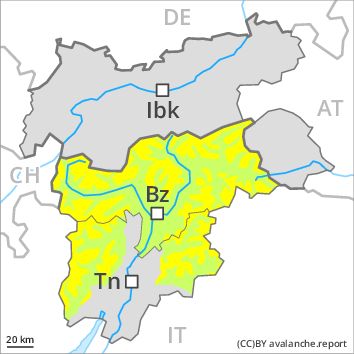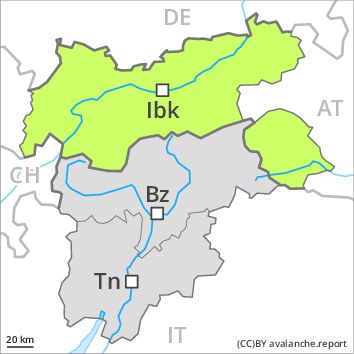Regions
Sexten Dolomites, Latemar, Val Müstair Alps, Langtaufers, Schnals Ridge, Southern Stubai Alps, Southern Zillertal Alps and High Tauern, Saldurn-Mastaun Ridge, Texel Mountains, Southern Adamello, Sarntal Alps, Adamello - Presanella, Western Pfunderer Mountains, Northern Brenta - Peller, Southern Brenta, Southern Lagorai, Northern Lagorai, Maddalene, Eastern Pfunderer Mountains, Durreck Range, Western Rieserferner Mountains, Western Deferegger Alps, Ortler Range, Ulten Valley, Eastern Nonsberger Alps, Northern Dolomites of Fiemme, Gröden Dolomites, Primiero - Pale di S. Martino, Prags Dolomites, Fassa Valley, Sole, Pejo and Rabbi

Danger level
Danger Level 2 - Moderate above 2400m
Danger Level 1 - Low above 2400m
Avalanche Problem
Wind-drifted snow above 2400m, N-NE-NW

The backcountry touring conditions are generally favourable.
The somewhat older wind slabs must be evaluated with care and prudence in particular on very steep northwest, north and northeast facing slopes above approximately 2400 m. Single backcountry tourers can release avalanches in some places. Mostly they are rather small. The wind slabs are clearly recognisable to the trained eye. Avalanches can be released in the old snowpack and reach quite a large size, in particular on very steep shady slopes as well as adjacent to ridgelines. Transitions from a shallow to a deep snowpack are unfavourable. A latent danger of gliding avalanches exists. Areas with glide cracks are to be avoided.
Snowpack
The snowpack will be subject to considerable local variations. In some cases the wind slabs have bonded still only poorly with each other and the old snowpack. In some places wind slabs are lying on old snow containing large grains, in particular on shady slopes as well as adjacent to ridgelines.
Tendency
The avalanche danger will persist.
Regions
Prealps, Cembra Valley, Bondone and Stivo, Vallarsa, Western Nonsberg Alps, Folgaria - Laverone, Ledro Valley, Paganella, Marzola - Valsugana, Pine' - Mocheni Valley

Danger level
Danger Level 2 - Moderate above the treeline
Danger Level 1 - Low above the treeline
Avalanche Problem
Wind-drifted snow above the treeline, N-NE-E-SE-S-SW-W-NW
Gliding snow above 2200m, SE-S-SW-W-NW

Moderate, level 2. Wind slabs require caution, especially adjacent to ridgelines. Gliding snow is to be evaluated with care and prudence, in particular on very steep sunny slopes at the base of rock walls.
Fresh and somewhat older wind slabs are easy for the trained eye to recognise and can be released easily especially at their margins. Even single persons can release avalanches in isolated cases, including medium-sized ones, in particular adjacent to ridgelines and in pass areas. The avalanche prone locations are to be found also at transitions from a shallow to a deep snowpack above approximately 2200 m. Off-piste activities call for experience in the assessment of avalanche danger and careful route selection. In steep terrain there is a danger of falling on the icy crust. Backcountry touring calls for great caution and restraint, in particular on very steep shady slopes. In particular in starting zones where no previous releases have taken place at any time medium-sized and, in isolated cases, large gliding avalanches and moist snow slides are possible below approximately 2200 m.
Snowpack
The fresh and somewhat older wind slabs are to be found in particular adjacent to ridgelines and in gullies and bowls in all aspects and at elevated altitudes. These are bonding only slowly with the old snowpack in particular on steep shady slopes at high altitude. Faceted weak layers exist deep in the old snowpack in areas where the snow cover is rather shallow, especially at high altitude on steep northeast, north and northwest facing slopes. The surface of the snowpack will freeze to form a strong crust and will soften during the day. The old snowpack will be moist at low and intermediate altitudes.
Tendency
A latent danger of ground avalanches exists, in particular on steep grassy slopes below approximately 2200 m.
Regions
Western Verwall Mountains, Eastern Verwall Mountains, Silvretta, Samnaun Mountains, Northern Oetz and Stubai Alps, Western Tuxer Alps, Eastern Tuxer Alps, Western Kitzbühel Alps, Eastern Kitzbühel Alps, Glockturm Range, Weißkugel Range, Gurgler Range, Central Stubai Alps, Northern Zillertal Alps, Allgäu Alps, Venediger Range, Eastern Lechtal Alps - Ammergau Alps, Mieming Mountains, Eastern Rieserferner Mountains, Karwendel Mountains, Glockner Range, Eastern Deferegger Alps, Brandenberg Alps, Wilder Kaiser Mountains - Waidring Alps, Schober Mountains, Lienzer Dolomites, Western Lechtal Alps, Central Lechtal Alps, Grieskogel Mountains

Danger level
Danger Level 1 - Low
Avalanche Problem
Wind-drifted snow above the treeline, N-NE-NW

A mostly favourable avalanche situation will be encountered over a wide area. Wind slabs require caution.
The fresh and somewhat older wind slabs are to be evaluated with care and prudence above the tree line. The avalanche prone locations are to be found in particular on northwest to north to northeast facing wind-loaded slopes. Mostly avalanches are only small but can be released in isolated cases by a single winter sport participant. The wind slabs are clearly recognisable to the trained eye.
A latent danger of gliding avalanches exists.
Dry avalanches can in very isolated cases be released in the old snowpack, mostly by large additional loads, in particular on very steep shady slopes. Transitions from a shallow to a deep snowpack are unfavourable.
Snowpack
dp 6: cold, loose snow and wind
The sometimes storm force wind has transported some snow. In some places wind slabs are lying on old snow containing large grains, in particular on shady slopes.
Faceted weak layers exist deeper in the old snowpack in particular in areas where the snow cover is rather shallow, especially on very steep shady slopes.
Tendency
Gradual increase in danger of gliding avalanches as a consequence of warming.



